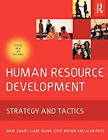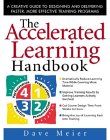|
|

The Value of Lectures |
| Blog | Biography | Business | Children | Computing | Fiction | Cooking | Garden | History | Learning | Psychology | Travel | Erectile Dysfunction |
| BestBooks Home US Bestsellers UK Bestsellers France - Meilleurs Ventes Canada Bestsellers Germany Bestsellers Erectile Dysfunction |
 Human Resource Development: Strategy and Tacticsby Juani Swart, Clare Mann, Steve Brown and Alan PriceThis book examines the factors influencing the effectiveness of an individual's learning, how people learn and the assessment of training and learning needs, showing the significance of aligning departmental, group and individual HRD objectives with business goals. More information and prices from: Amazon.co.uk - British pounds Amazon.com - US dollars SeekBooks.com.au - Australian Dollars Amazon.ca - Cdn dollars Amazon.de - Euros Amazon.fr - Euros
 The ASTD Training and Development Handbook: A Guide to Human Resource Developmentby Robert L. Craig (Editor)The ASTD Training and Development Handbook, Fourth Edition, by Robert L. Craig, is bursting with great new training ideas that'll help you work your magic in your organization. Top industry leaders give 100s of practice-proven techniques you can use right now. More information and prices from: Amazon.com - US dollars SeekBooks.com.au - Australian Dollars Amazon.ca - Canadian dollars Amazon.co.uk - UK pounds Amazon.de - Euros Amazon.fr - Euros  The Accelerated Learning Handbook: A Creative Guide to Designing and Delivering Faster, More Effective Training Programsby Dave MeierAccelerated learning is the use of music, color, emotion, play, and creativity to involve the whole student and enliven the learning experience. The Accelerated Learning Handbook is the first definitive book to explain state-of-the-art accelerated learning techniques to trainers and teachers, and features 40 techniques designed to save money while producing far better results. More information and prices from: Amazon.com - US dollars SeekBooks.com.au - Australian Dollars Amazon.ca - Canadian dollars Amazon.co.uk - British pounds Amazon.de - Euros Amazon.fr - Euros |
The Value of LecturesBy Alan Price, adapted from chapter 9 of Human Resource Development: Strategy and TacticsThe lecture is probably the most common and yet the most heavily criticised of all learning methods (Bligh, 1998). Learners often favour this method because it is almost entirely passive and demands little from them except the appearance of being awake. Trainers (and budget holders) appreciate that information can be thrown at large numbers of people comparatively cheaply. It is also a wonderful opportunity for those with a streak of extraversion to take the stage and expound on their favourite ideas without the intellectual challenge of debate. But is it an effective method of learning? The didactic nature of the lecture has attracted criticism. For example, in a university context, Barnett (2000: 159) describes the lecture as a:'... refuge for the faint-hearted ... it keeps channels of communication closed, freezes hierarchy between lecturer and students and removes any responsibility on the student to respond ... the students remain as voyeurs; the lecture remains a comfort zone ... the student watches a performance and is not obliged to engage with it' Nevertheless, the lecture can be a useful medium through which to convey broad ideas about a particular subject. But the lack of interaction means that misunderstanding may result and clarity on certain issues may not be sought. Success is dependent on a number of factors such as:
Saroyan and Styles (1997, cited in Jin, 2000) provide the following framework for evaluating lectures: 1. Strategy: appropriateness of level of instructional strategy (synergy between long-term learning plan and student acceptance level). 2. Organization:
3. Clarity:
Jin (2000) identifies another element that is important in determining the popularity and effectiveness of a lecture: its entertainment value. This is particularly significant with very large groups, especially if they contain uncommitted or less able people among the audience. Describing a university situation, Jin observes that: "Students like to enjoy lectures (so do lecturers, of course). The list of features referring to an entertainment dimension can be very long. For example, good lectures were described as 'interesting, not boring', 'humorous not stern', 'charismatic not weak'. Much less attention was paid to the education aspect. Boring lectures were always the focus of student complaint. They did not like a dull atmosphere in the classroom. They liked jokes and they wanted to be entertained. Many groups mentioned the word charismatic. Lecturers are the focal point of the classroom and students expect them to show that they can maintain the audience's attention, by means of good communication skills and the right personality." Recent opinion has tended to be slightly more favourable to the lecture as a vehicle of learning. For example, Ward and Lee (2004) found no significant difference in test scores between groups of students randomly allocated to lecture-based and problem-based learning programmes. However, Nadkami (2003) identified more complex mental models being used by learners who had received a mixture of lecture and experiential learning methods than those who had been provided with one of those methods alone. Brookfield and Preskill (1999) argue that the lecture method can be integrated with discussion techniques: "One of the traps that advocates of discussion methods often fall into is setting up a false dichotomy between lecturing and discussion ... If you lecture, so their argument goes, you only serve to confirm your authoritarian, demagogic tendencies. This is a disservice to well-intentioned colleagues and a gross misunderstanding of pedagogical dynamics ... We believe this pedagogical bifurcation is wrong. Lectures are not, in and of themselves, oppressive and authoritarian ... Similarly, discussions are not, in and of themselves, liberating and spontaneous ... Instead of reducing questions of pedagogical method to a simplistic dichotomy-discussion good, lecture bad-we see these two methods as complementary ... We want to argue that lectures can provide a wonderful opportunity for teachers to model the ... dispositions they wish to encourage in discussion." (pp. 45-46 cited in Sutherland, 2003). Brookfield and Preskill also suggest a number of ways in which lectures can be used to develop discussion, including:
Finally, we should consider the importance of the lecturer's enthusiasm or passion for the subject. Meier (2000: 238) argues that passion is an essential ingredient in a good training programme, holding that 'subjects taught in a mechanical, perfunctory, emotionless way tend to fall flat for the learner.' He adds: "Books about training and train-the-trainer programs tend to emphasize the trainer's use of methods, techniques, and media and tend to overlook the one thing needful - the trainer's passion for the subject. Any learning program becomes shallow and ineffective when it's all techniques and no heart."
Excerpts from Chapter 5, The Trainer's Handbook |
|
|
|
|
|
|
|
|
|
|
|
| Copyright © 2000-2005 Alan Price and BestBooks.biz contributors. All rights reserved. |